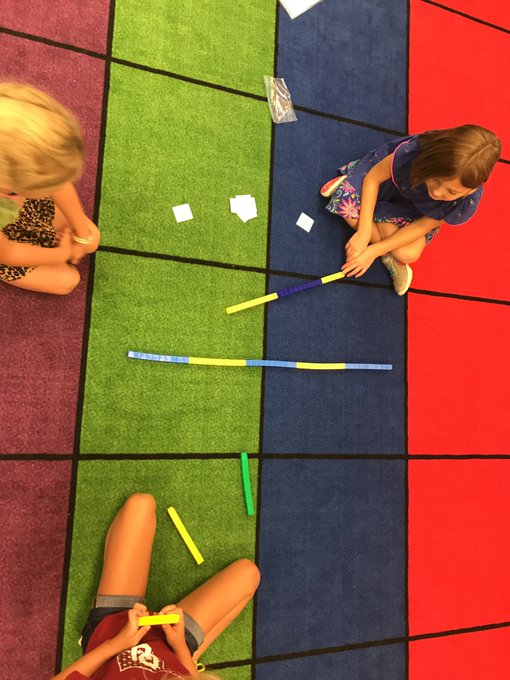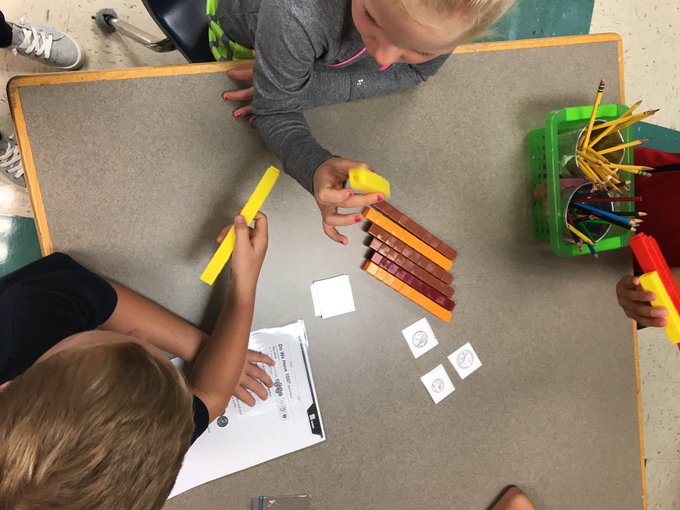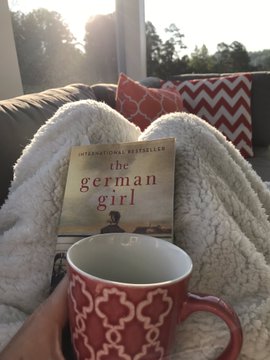Upcoming blog posts will be laid out by content. You can read about each subject we are covering. I will talk about what we are learning and include some helpful hints on how to help your child at home.
Math:
The first unit of study is simply seeing what they know, reviewing helpful tools (hundreds chart, number line, etc), introducing games, and simply understanding how the math period will flow. This past week, we used the hundreds chart to count AND solve simple addition and subtraction problems, began skip counting, identified and counted coins, and solved simple word problems together. Our biggest focus was making sure students could count 100 objects. We talked about different strategies, such as counting by twos and placing them in groups of 10 so that anytime I walked up and asked how many they had counted, they would easily be able to tell me. We used colored cubes so they could count ten of each color, as in the pictures below. We also reviewed the identification of coins, their value, and counting them (using cubes as a backup counter). Most students were able to do both of these tasks, but it doesn't hurt to practice. Below are ways to help your child grow as mathematicians.


Ways to help at home:
- Pull out 100+ pennies or beans or... and ask your child to count them. Students should remember to place them in groups of 5 or 10 so they can easily figure out what number they are on should they get confused.
- Ask your child to identify different coins, count a handful of change, and make $1.00 with different coins.
Word Study:
We have begun the year with one word list for all students, which are sight words. Students learned the structure of this time, as well as my expectations in their journals. We will continue the upcoming week with a new sight word list and add to our activity set and my expectations for those activities.
Ways to help at home:
- Ask your child to spell easy, commonly used words when you are writing a note or a list. Remember that words we think are easy (like was or one or what) can be challenging for them because some words don't sound like they are spelled...was sounds like it should be spelled wuz. Choose words that can easily be sounded out.
- I will be teaching students a strategy for harder words using lines. For instance, if we spelled sneaky, I would ask students to count the sounds (5), so we draw 5 lines, like this _ _ _ _ _. Then we begin filling in the lines with the sounds we heard.
s _ _ _ _ then
s n _ _ _ then
s n e _ _ then
s n e k _ then
s n e k e
I explain that this might not be exactly how to spell the word, but it would be super close! From this point, students can then use what they know from word study to get even closer. If they have had the long e sort with ea, then they know they could put an ea on the third line. If they know that some long e sounds at the end of a word will end with an i, ie or y. They can then add them and see which one looks familiar. Ask your child to use this strategy at home. We are just learning it, but as the year progresses, students will become very good at it.
Writing:
We began the year with a drawing prepared by each student at the table. Each student got a piece of paper and drew legs (some drew 8 legs!). We then rotated the paper to a new person and that person drew the body. We then rotated again and that person drew the head (one person had 4 heads!), and the last person drew arms. The paper was then returned to the original owner who added details and began writing about it.
Writing this week will include reading books and making lists of "things to write about" for idea generation. Students will make a list of who they could write about, places they could write about, favorite things they could write about, and experiences they could write about. We will read books that use these components and then I will use my list to create a true story about a time my daughter and I were snorkeling in Kauai and saw a Hawaiian Monk Seal and a completely fictional story about a green monkey (my favorite animal) who photo bombed a wedding at a temple outside Tokyo (a place I visited). Students will then be able to explore how their own experiences can help them write a wonderful story.
Ways to help at home:
Students can write at home. They could help you with the grocery list, write a letter to family or friends, or just write a creative story. There are two great apps you can get for your phone (Name Dice and Story Dice by Thinkamingo) that will help when they are stuck. The Name Dice pops up 2 names at a time and the Story Dice shows 2 or 3 pictures that generate a "situation" that students can write about. I only allow students to tap it 3 times for ideas or they might get carried away with tapping and not actually thinking about what the picture on the dice could do for their story.
Reading:
We began this week by learning to choose a "just right" book. We watched a short video on the story of Goldilocks and how she needed to have "just right" porridge, a "just right" chair, and a "just right" bed. Reading is very similar because we can't have books that are too hard or we might get bored with those that are too easy. We have to find "just right" books as well. We talked about finding books that are of interest, that they can comprehend, and that they know how to read. At this time, students are only allowed to choose books from certain bins (easier books). I will open up other bins and genres after I am able to more formally assess them. I already know a few students who are either above or below the bins that are available to students, so my hope is to assess those students first so they can get into more "just right" books quickly and don't get bored or frustrated.
This week, students were asked to think of themselves as readers (how do they like to read, with whom do they like to read, and who are model readers they want to be like). Students answered a survey, drew pictures, and wrote about their reflection as a reader. I told students that I love to hike and read and combining those two things make me happy, so my favorite place to read is near a waterfall! So, we listened to a YouTube channel with waterfall and bird sounds. They gave me a big thumbs up! :) Here is my new favorite place to read on a Saturday morning (my new back porch).

We spent quite a bit of time talking and reflecting on reading and were able to make it about 9 minutes of straight reading before several students got bored and started looking around. At that time, we moved around and started again. Eventually, students will get to the point where they can read for 30-40 minutes straight and will get cranky when I tell them it's time to clean up! :)
Ways to help at home:
- The hardest part about reading at home is that you don't know if a book is a "just right" book. If your child has a book that you aren't sure is a good fit, ask them to read a page or two to you. If there are more than 5 words that your child does not know, the book is "too big." If your child can read it, but doesn't really know what it means, it is only a little "too big." Either have them choose a different book or read along with them and ask them questions.
- Don't feel that your child is ever too old to read a book together. Children learn through your modeling! Have your child read to you, share the book and each of you read a page, or you read to your child if the book is "too big." All of these are wonderful ways to spend quality time with your child.
- 20 minutes of reading each day will help immensely! This will be their homework for the remainder of the year.
Social Studies:
In social studies, we discussed ways to be a super citizen. This even broadened this topic through other content areas this week (being a super citizen in reading and writing workshop)! Students were able to clearly explain how they could be a super citizen of our classroom community, school community, city community, national community, and global community.
Students were able to clearly distinguish the difference between rules and laws. They know rules are made by groups of people and each person is held accountable on their own, but laws are made and upheld by the government. Students provided examples of rules (being respectful, following directions, etc) and laws (obeying the speed limit and not stealing). FYI - we went the simple route and didn't get into inappropriate laws! :)
Ways to help at home:
- When taking a family walk, pick up trash and talk about how super citizens help the community become a better place to live, work and play.
- If you are driving, discuss the different laws you have to obey (stopping at a stop sign, driving the speed limit, etc.)
Wonderful! Thank you Mrs. Palmer.
ReplyDelete